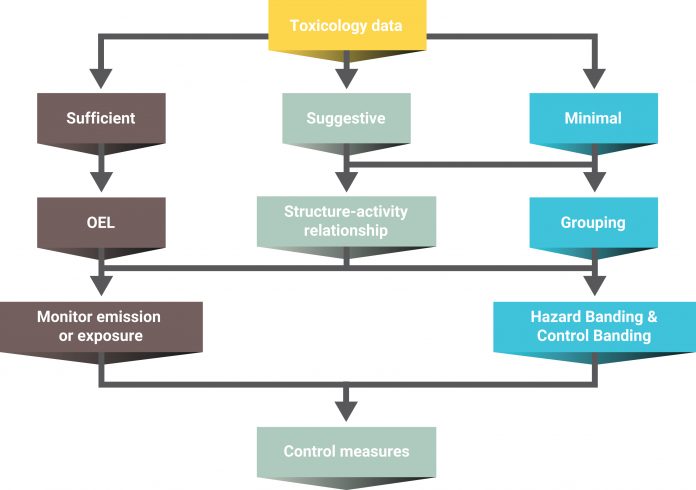Dr Dimiter Prodanov from IMEC vzw shares his views on the fascinating world of nanomaterials including the governance of nano-related risk
Nanomaterials are fascinating for the wealth of modified properties that they possess, which can be used by the industry. On the other hand, they are not different materials per se, rather they are “nanoform” variations of ordinary materials: for example, silicon dioxide, which can be found in glass or quartz.
In a different nanoform, silica nanoparticles are used in certain polishing steps in chip manufacturing. The industrial processes, which use nanomaterials need to be comprehensively evaluated for their benefits and risks. This is the object of study of nano safety – it is a field which identifies the particular risks introduced by the use of nanoforms and nanomaterials in the product lifecycle.
Furthermore, a holistic view of the nano-hazard and the related process risk is crucial for successful integration of nano safety aspects into the overall risk management methodology. Material properties, health effects, the potential for release and occupational exposure are principal aspects of successful risk mitigation. In this article, I focus on the risk, which can arise in an occupational setting.
Traditional chemical risk assessment tools are based on the quantitative dose-response relationship, which is augmented by a threshold defining the no-effect levels – that is the occupational exposure limit (OEL, see Figure). Such quantitative risk assessment is applicable in cases when sufficient toxicological and occupational exposure data are available. However, this is not the case for the majority of nanomaterials.
The main challenges are the size and shape-dependence of the toxic effects, which can be substantially modified by applied functionalisation or the interactions with the environment in the body. Therefore, the current expert opinion tends to agree that conventional risk assessment tools have limited applicability to nanomaterials or nanoforms. Due to insufficient information, at present, there are no legally defined OELs for nanomaterials, which slows down industrial acceptance of nanomaterials and hampers consumer confidence.
These shortcomings can be tackled by using grouping principles for the novel nanomaterials. Such an approach can be implemented by the risk and control- banding risk assessment tools. Efforts in the direction of the grouping of nanomaterials and read-across missing properties of nanoforms are encouraged by the stakeholders, such as the nanotechnology industry, national regulators and international bodies, like EU and OECD.
Identifying methodologies for risk assessment and governance of such situations is part of the work undergoing in the H2020 project NanoStreeM, which targets the semiconductor industry. The NanoStreeM consortium has taken up the challenge in defining ”Roadmap Nanomaterials: Strategies For Safety Assessment In Advanced Integrated Circuits Manufacturing”, where we identify the existing gaps in our knowledge and formulate a number of recommendations for their mitigation.
To date, a total of 32 risk assessment tools have been identified under quantitative and qualitative methodologies. Based on the identified potential exposure scenarios, a detailed recommendation focusing on a key group of four risk assessment tools has been developed. At present, the efforts of the NanoStreeM project are focused on the evaluation of the proposed risk governance paradigms, starting with the ISO TS 12901-2:2014 standard. We have prioritised several common tools for the semiconductor industry scenarios. The consortium industrial partners evaluate so-identified risk assessment tools and compare them to the available emission measurements.
Although, the project has still about one more year to run, several key findings have come into view.
The standard safety data sheets for chemical products do not contain information about the eventual presence of nanoforms and their characteristics. This makes the information easy to miss by the safety professionals.
We have established a necessity for the grouping of nanomaterials to similarity groups (i.e. such as hazard bands or classes). The health and safety assessment can be empowered by the availability of international standards, such as the ISO/TS 12901-2:2014.
There is a growing body of data related to potential exposure scenarios both to the worker and environment for nanomaterials currently in use in semiconductor manufacturing. Such information should be incorporated into appropriate exposure models to facilitate health and safety assessments.
To address challenges in nanomaterial risk assessments the H2020 projects NanoStreeM and caLIBRAate, with the support of the Royal Belgian Academy for Arts and Sciences, Flanders, organise a joint workshop entitled: “Governance of emerging nano-risk in semiconductor industry”.
The workshop will take place in Brussels on 26th April 2018. The event will bring together regulators, policy makers, the growing risk governance community for nanomaterials, as well as industrial producers and end-user companies. The meeting will present how and where nanomaterials are used in the semiconductor industry based on the findings of the NanoStreeM project.
The project caLIBRAte will present nanomaterials risk governance frameworks, which could be applied to the semi-conductor industry. The workshop will conclude with a panel discussion on the steps necessary to further enable the use of nanomaterials throughout the industry and appropriately govern the emergent risks. The meeting outcome will identify the challenges and regulatory issues in semi-conductor industry and how risk governance tools for nanomaterials can support effective business operation. More information is available on the event web-page.
Acknowledgement
The NanoStreeM project (Nanomaterials: strategies for safety assessments in advanced integrated circuits manufacturing) receives funding from the European Union’s Horizon 2020 Research and Innovation Programme under grant agreement n° 688794.
Please note: this is a commercial profile
Dr Dimiter Prodanov
IMEC vzw
Tel: +32 162 818 40











